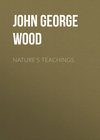Loe raamatut: «Bible Animals», lehekülg 33
These birds are taken in nets, into which they are decoyed by a very effective though cruel device.
When one of these birds is trapped or snared, it is seized by its capturers, who spare its life for the sake of using it as a decoy. They blind it by sewing its eyelids together, and then fasten it to a perch among trees. The miserable bird utters plaintive cries, and continually flaps its wings, thus attracting others of its kind, who settle on the surrounding branches and are easily taken, their whole attention being occupied by the cries of their distressed companion.
We now come to the Turtle Doves, several of which inhabit the Holy Land; but, as they are similar in habits, we will confine ourselves to the common species (Turtur auritus), with which we are so familiar in this country. The Hebrew word which is translated as Turtle, is tôr, a term which is usually employed in connexion with the word yônâh, or Dove, thus, tôr-yônâh. The name is evidently derived from the note of the bird.
The reader may remember that on page 414, a curious tradition has been mentioned respecting the word tôr; namely, that it represented the age, and not the species of a Dove. There is but little doubt, however, that the word really does represent a species, and that the Turtle Dove is the bird signified by the word tôr. For example, its migratory habits are noticed in the sacred writings. See the following passage in the Song of Solomon.

THE TURTLE DOVE.
"The voice of the turtle is heard in our land."—Cant. ii. 12.
"Lo, the winter is past, the rain is over and gone; the flowers appear on the earth; the time of the singing of birds is come, and the voice of the turtle is heard in our land" (Cant. ii. 11, 12). The prophet Jeremiah also refers to the migration of this bird: "Yea, the stork in the heaven knoweth her appointed times; and the turtle, and the crane, and the swallow observe the time of their coming: but my people know not the judgment of the Lord" (viii. 7).
Beside this species, there is the Collared Turtle Dove (Turtur risorius), one variety of which is known in England as the Barbary Dove. It is a large species, measuring more than a foot in length. Another species is the Palm Turtle (Turtur Senegalensis), so called from its habit of nesting on palm-trees, when it is obliged to build at a distance from the habitations of man. It is a gregarious bird, several nests being generally found on one tree, and even, when it cannot find a palm, it will build among the thorns in multitudes. Like the common Dove, it is fond of the society of man, and is sure to make its nest among human habitations, secure in its knowledge that it will not be disturbed.
It is rather a small bird, being barely ten inches in length, and having no "collar" on the neck, like the two preceding species.
POULTRY
Poultry plentiful in Palestine at the present day—The Domestic Fowl unknown in the early times of Israel—The eating and gathering of eggs—References to Poultry in the New Testament—The egg and the scorpion—The fatted fowl of Solomon—The hen brooding over her eggs—Poultry prohibited within Jerusalem—The cock-crowing.
At the present day, poultry are plentiful both in Palestine and Syria, and that they were bred in the time of the Apostles is evident from one or two references which are made by our Lord. How long the Domestic Fowl had been known to the Jews is extremely uncertain, and we have very little to guide us in our search.
That it was unknown to the Jews during the earlier period of their history is evident from the utter silence of the Old Testament on the subject. A bird so conspicuous and so plentiful would certainly have been mentioned in the Law of Moses had it been known to the Israelites; but, in all its minute and detailed provisions, the Law is silent on the subject.
Neither the bird itself nor its eggs are mentioned, although there are a few references to eggs, without signifying the bird which laid them. The humane provision in Deut. xxii. 6, 7, refers not to a domesticated, but to a wild bird: "If a bird's nest chance to be before thee in any tree, or on the ground, whether they be young ones, or eggs, and the dams sitting upon the young, or upon the eggs, thou shalt not take the dam with the young: but thou shalt in any wise let the dam go, and take the young to thee; that it may be well with thee, that thou mayest prolong thy days."
That eggs were used for food, is seen from Job vi. 6: "Can that which is unsavoury be eaten without salt? or is there any taste in the white of an egg?" So in Isa. lix. 5: "They hatch cockatrice' eggs, and weave the spider's web: he that eateth of their eggs dieth."
There is another passage in the same book which refers to the gathering of eggs as mentioned in Deut. xxii. "And my hand hath found as a nest the riches of the people: and as one gathereth eggs that are left, have I gathered all the earth" (Isa. x. 14). The well-known passage in Luke xi. 11, 12, however, evidently refers to the ordinary hen's egg, which was used then for food just as is the case at the present day: "If a son shall ask bread of any of you that is a father, will he give him a stone? or if he ask a fish, will he for a fish give him a serpent?
"Or if he shall ask an egg, will he offer him a scorpion?"
There is but one passage in the Old Testament which has ever been conjectured to refer to the Domestic Fowl. It occurs in 1 Kings iv. 22, 23, among the list of the daily provision of Solomon's household: "And Solomon's provision for one day was thirty measures of fine flour, and threescore measures of meal,
"Ten fat oxen, and twenty oxen out of the pastures, and an hundred sheep, beside harts, and roebucks, and fallow-deer, and fatted fowl."
Now the word which is here rendered as "fatted fowl" is in the Hebrew, barberim. Judging by the etymology of the word, which is derived from a root that signifies whiteness, or purity, it has been thought that the correct rendering would be "fattened white" (birds). Some Hebraists have conjectured that the white birds in question were geese, this term including various white birds, swans among the number.
Many persons think that the fatted fowl mentioned in the above-quoted passage were really Domestic Fowl, which Solomon had introduced into Palestine, together with various other birds and animals, by means of his fleet. There may be truth in this conjecture, but, as there can be no certainty, we will pass from the Old Testament to the New.

THE DOMESTIC FOWL.
"As a hen doth gather her brood under her wings."—Luke xiii. 34.
We are all familiar with the passages in which the Domestic Fowl is mentioned in the New Testament. There is, for example, that touching image employed by our Lord when lamenting over Jerusalem: "O Jerusalem, Jerusalem, thou that killest the prophets, and stonest them that are sent unto thee; how often would I have gathered thy children together, as a hen doth gather her brood under her wings, and ye would not!" The reference is evidently made to the Domesticated Fowl, which in the time of our Lord was largely bred in the Holy Land.
Some writers have taken objection to this statement in consequence of a Rabbinical law which prohibited poultry from being kept within the walls of Jerusalem, lest in their search for food they should scratch up any impurity which had been buried, and so defile the holy city. But it must be remembered that in the time of Christ Jerusalem belonged practically to the Romans, who held it with a garrison, and who, together with other foreigners, would not trouble themselves about any such prohibition, which would seem to them, as it does to us, exceedingly puerile, not to say unjustifiable. Whether the Jews obeyed or disregarded the prohibition, it is evident that it would have been binding on the Jews alone, and that all Gentiles were exempt from it. Some commentators have even thought that the Domestic Fowl was not known in Palestine until imported by the Romans.
That the bird was common in the days of our Lord is evident from the reference to the "cock-crowing" as a measure of time.
Even on this subject there has been much controversy, some persons thinking that the words are to be understood in their literal sense, and others that they are merely metaphorical, and refer to the divisions of time under the Romans, which were marked by the blowing of trumpets, conventionally termed cock-crowings. There is, however, no necessity to search for a metaphorical meaning when the literal interpretation is clear and intelligible. At the present day, as in all probability in the time of our Lord, the crowing of the cocks is employed as a means of reckoning time during the night, the birds crowing at certain hours with almost mechanical regularity.
THE PEACOCK
The foreign curiosities imported by Solomon—The word Tucciyim and its various interpretations—Identity of the word with the Cingalese name of the Peacock—Reasons why the Peacock should have been brought to Solomon—Its subsequent neglect and extirpation.
Among the many foreign objects which were imported by Solomon into Palestine, we find that the Peacock is specially mentioned. (See a passage which has already been mentioned in connexion with ivory and apes.) The sacred historian, after mentioning the ivory throne, the golden shields and targets, that all the vessels in Solomon's house were of gold, and that silver was so common as to be of no account, proceeds to give the reason for this profuse magnificence. "For the king had at sea a navy of Tharshish with the navy of Hiram: once in three years came the navy of Tharshish, bringing gold, and silver, ivory, and apes, and peacocks" (1 Kings x. 22).
The word which is here translated as Peacock is in the Hebrew tucciyim, and has been rendered in various modes. The Jewish Bible accepts the same translation as our own, and does not even affix the mark of doubt. Some Hebraists have rendered the word as "parrots," while others have tried to identify the Tucciyim with guinea-fowls.
In the identification of any animal, much must necessarily depend on the country in which it is found. Now, if the reader will refer to page 2 of this work, he will see that India and Ceylon are identified as the land visited by Solomon's ships. In the latter island are found all the three valuables which are mentioned in the above-quoted passage, and it is remarkable that the Cingalese name for the Peacock is so similar to the Hebrew word, that we have every reason to believe that the word tucciyim or tuyeyim is in reality a Hebraic form of the Cingalese tokei. A similar resemblance of name occurs in the Hebrew and Cingalese terms for ape and elephant.

THE PEACOCK.
"Once in three years came the navy of Tharshish, bringing gold, and silver, ivory, and apes, and peacocks." 1 Kings x. 22.
That this magnificent bird should have been one of those creatures that were imported by Solomon is almost certain. It would be imported for the same reason as the apes; namely, for the purpose of adding to the glories of Solomon's house, and no bird could have been selected which would have a more magnificent effect than the Peacock. Moreover, although unknown in Palestine, it is extremely plentiful in its native land, inhabiting the jungle by thousands, and, by a curious coincidence, being invariably most plentiful in those spots which are most frequented by tigers. In many parts of the country, great numbers of Peacocks frequent the temples, and live amicably with the sacred monkeys, passing their lives in absolute security, protected by the sanctity of the place.
Their numbers, therefore, would render them easily accessible to Solomon's envoys, who would purchase them at a cheap rate from the native dealers, while their surpassing beauty would render them sure of a sale on their arrival in Jerusalem. Indeed, their beauty made so great an impression that they are separately mentioned by the sacred chronicler, the Peacock and the ape being the only two animals that are thought worthy of enumeration.
It seems that after Solomon's death the breed of Peafowl was not kept up, owing in all probability to the troubles which beset the throne after that magnificent monarch died.
THE PARTRIDGE
The word Kore and its signification—The Partridge upon the mountains—David's simile—The Desert Partridge and its habits—Hunting the Partridge with sticks—Eggs of the Partridge—A disputed reading, and probable signification of the passage—Egg-hunting in Palestine—The various species of Partridge—The Francolin and the Sand-grouse.
There is a bird mentioned in the Old Testament, which, although its name is only given twice, is a very interesting bird to all students of the Scriptures, both passages giving an insight into the manners and customs of the scarcely changing East. This is the bird called in the Hebrew Kore, a word which has been generally accepted as signifying some kind of Partridge. There is no doubt that, like most other Hebrew names of animated beings, the word is a collective one, signifying a considerable number of species.
The first passage occurs in 1 Sam. xxvi. 20. When David was being pursued by Saul, and had been forced to escape from the city and hide himself in the rocky valleys, he compared himself to the Partridge, which frequented exactly the same places: "The king of Israel is come out to seek a flea, as when one doth hunt a partridge upon the mountains."
The appositeness of this simile is perfect. The bird to which David alluded was in all probability the Desert Partridge (Ammoperdix Heyii), a species which especially haunts rocky and desert places, and even at the present day is exceedingly plentiful about the Cave of Adullam. The males, when they think themselves unobserved, are fond of challenging, or calling to each other in a loud ringing note, a peculiarity that has earned for the bird the Hebrew name of Kore, or "the caller."
It is a very active bird, not taking to flight if it can escape by means of its legs, and, when pursued or disturbed, running with great swiftness to some rocky cleft in which it may hide itself, taking care to interpose, as it runs, stones or other obstacles between itself and the object of its alarm. Thus, then, it will be seen how close was the parallel between this bird and David, who was forced, like the Partridge, to seek for refuge in the rocky caves.
But the parallel becomes even closer when we come to examine the full meaning of the passage. The Partridge is at the present day hunted on the mountains exactly as was the case in the time of David. The usual hunters are boys, who provide themselves with a supply of stout sticks about eighteen inches in length, and, armed with these, they chase the birds, hurling the sticks one after the other along the ground, so as to strike the Partridge as it runs. Generally, several hunters chase the same bird, some of them throwing the sticks along the ground, while others hurl them just above the bird, so that if it should take to flight, it maybe struck as it rises into the air. By pertinaciously chasing an individual bird, the hunters tire it, and contrive to come so close that they are certain to strike it.

THE GREEK PARTRIDGE.
"A partridge upon the mountains."—1 Sam. xxvi. 20.
Rude as this mode of bird-hunting may seem, it is still employed in some parts of England, and is effective even against birds far more active on the wing than the Partridge. I have seen snipe killed in the New Forest by being hunted down with sticks. Squirrels are chased and killed in a similar manner, except that the "bolts," or the sticks for squirrel-hunting, are weighted with lead at one end.
The reader will now see how perfect is the image. Driven from the city, David was forced to wander, together with the Desert Partridge, upon the hill-sides, and, like that bird, his final refuge is the rock. Then came the hunters and pursued him, driving him from place to place, as the boys hunt the Partridge, until he was weary of his life, and exclaimed in his despair, "I shall now perish one day by the hand of Saul."
The second passage in which the word kore is found occurs in Jer. xvii. 11: "As the partridge sitteth on eggs, and hatcheth them not; so he that getteth riches, and not by right, shall leave them in the midst of his days, and at his end shall be a fool." The marginal reading of this passage gives the sense in a slightly different form, and commences the verse as follows: "As the partridge gathereth (young) which she hath not brought forth, so he," &c. The Jewish Bible gives the whole passage rather differently from both these readings: "A partridge hatching what it hath not laid (or borne), is he that getteth (or maketh) riches, and not by right (or judgment): he shall leave them in the midst (or half) of his days, and at his end shall be base."
Taking all these readings, and comparing them with the original, with each other, and with the context, we can have but little doubt that reference is made by the prophet to the number of unborn, i.e. unhatched, eggs on which the Partridge sits, but which are so often taken from her before they can be hatched. Just as hunting the Partridge is an acknowledged sport among the inhabitants of the uncultivated parts of Palestine, so is searching for the eggs of the bird a regular business at the proper time of year.
The Partridges of Palestine are, like those of our own land, exceedingly prolific birds, laying a wonderful number of eggs, more than twenty being sometimes found in a single nest. These eggs are used for food, and the consumption of them is very great, so that many a Partridge has been deprived of her expected family: she has sat upon eggs, and hatched them not.
Of these birds several species inhabit Palestine. There is, for example, the Desert Partridge, which has already been mentioned. It is beautifully, though not brilliantly, coloured, and may be known by the white spot behind the eye, the purple and chestnut streaks on the sides, and the orange bill and legs. These, however, soon lose their colour after death.
Then there is the Greek Partridge (Caccabis saxatilis), which is even more plentiful than the preceding species, and is more widely spread. It is a large bird of its kind, being much larger than our English species, and may be known by its size, the dark red legs and beak, and the bold bars on the sides.
Mr. Tristram suggests, with much probability, that the Francolin, or Black Partridge of India, and the Sand-Grouse, may be included among the number of the birds which are included under the common name of Kore. The latter bird is extremely plentiful in Palestine, and, in all probability, was classed by the unobservant Jews with the true Partridge.
THE QUAIL
Signification of the word Selâv—Various passages in which the word is mentioned—The locust, the stork, and the sand-grouse—Spreading the birds around the camp—Migration of the Quail—Drying the Quails for food—Modes of catching the Quail in the East—The Quail-hunters of Northern Africa—Quarrelsome nature of the bird—Quail-fighting in the East—How the Quails were brought to the Israelites.
In one or two parts of the Old Testament is found a word which has been translated in the Authorized Version of the Bible as Quail.
The word is selâv, and in every case where it is mentioned it is used with reference to the same occurrence; namely, the providing of flesh-meat in the wilderness, where the people could find no food. As the passages remarkably bear upon each other, it will be advisable to quote them in the order in which they come.
The first mention of the Selâv occurs in Exod. xvi. Only a few days after the Israelites had passed the Red Sea, they began to complain of the desert land into which Moses had led them, and openly said that they wished they had never left the land of their slavery, where they had plenty to eat. According to His custom, pitying their narrow-minded and short-sighted folly, the natural result of the long servitude to which they had been subject, the Lord promised to send both bread and flesh-meat.
"And the Lord spake unto Moses, saying,

THE QUAIL.
"The people asked, and He brought quails."—Psalm cv. 40.
"I have heard the murmurings of the children of Israel: speak unto them, saying, At even ye shall eat flesh, and in the morning ye shall be filled with bread; and ye shall know that I am the Lord your God.
"And it came to pass, that at even the quails came up, and covered the camp" (ver. 11-13).
The next passage records a similar circumstance, which occurred about a year afterwards, when the Israelites were tired of eating nothing but the manna, and again wished themselves back in Egypt. "And there went forth a wind from the Lord, and brought quails from the sea, and let them fall by the camp, as it were a day's journey on this side, and as it were a day's journey on the other side, round about the camp, and as it were two cubits high upon the face of the earth.
"And the people stood up all that day, and all that night, and all the next day, and they gathered the quails: he that gathered least gathered ten homers; and they spread them all abroad for themselves round about the camp" (Numb. xi. 31, 32).
The last passage in which Quails are mentioned occurs in the Psalms. In Ps. cv. are enumerated the various wonders done on behalf of the Israelites, and among them is specially mentioned this gift of the Quails and manna. "The people asked, and He brought quails, and satisfied them with the bread of heaven" (ver. 40).
We now have to ask ourselves what the word selâv really means. Some commentators have thought that it signified a species of locust, insects which travel in vast multitudes, and are always carried with the wind, thus agreeing with the statement that the Selavim were brought by the wind. Others have imagined that the Selavim were flying-fish, blown on shore as they rose from the sea after their fashion. Putting aside other reasons against these interpretations, the Psalms contain a passage which effectually contradicts them, and proves that the Selâv was a bird of some kind.
"He had commanded the clouds from above, and opened the doors of heaven,
"And had rained down manna upon them to eat, and had given them of the corn of heaven.
"Man did eat angels' food: He sent them meat to the full.
"He caused an east wind to blow in the heaven; and by His power He brought in the south wind.
"He rained flesh also upon them as dust, and feathered fowls like as the sand of the sea" (Ps. lxxviii. 23-27).
From this passage it is evident that the Selavim which were sent together with the manna were birds of some kind—"fowls of wing," according to the literal sense of the Hebrew; so that the theory that they were insects or fish must be dismissed as untenable. The question now remains, with what species of bird are we to identify the Selâv?
Respecting this question, there has been great discussion, chiefly arising from the fact that the various commentators endeavoured to show that the Selâv was not the Quail, but some other bird. Some, for example, take it to be the white stork, which is very plentiful in Palestine, and sometimes flies in such numbers that the sky is darkened as the winged host passes by. They base this supposition on the stature of the bird, which is so tall that it stands about "two cubits high upon the face of the earth." So it does, but this is a very insufficient reason for translating the word selâv as "stork."
In the first place, the words "as it were two cubits high upon the face of the earth" certainly do not refer to the stature of the individual birds. They are popularly taken to signify that the earth was covered with the bodies of the Selavim to the depth of three feet.
This, however, can hardly have been the fact, as in that case they would have utterly overwhelmed the whole camp, and crushed the tents by their weight. Moreover, there would have been no need of gathering them up, as they would have lain so thickly on the ground that the only trouble would have been to make a passage through them. It is not very easy to force a passage through snow a yard in depth, while to do so through the same depth of birds would have been almost impossible.
Neither could the Israelites have "spread them all abroad for themselves round about the camp." If the Selavim lay to the depth of a yard "as it were a day's journey on this side, and a day's journey on the other side of the camp," i.e. some eight or ten miles all round it, there would have been no space whereon the birds could have been spread. The sentence in question has a totally different signification, and refers to the height from the ground at which the birds fly. Taken in this sense, the whole passage falls into harmony, whereas in any other it involves a difficulty.
If the ordinary interpretation of selâv by "Quail" be accepted, the description is exactly correct. The Quails fly in vast flocks, and, being weak-winged birds, never fly against the direction of the wind. They will wait for days until the wind blows in the required direction, and will then take wing in countless multitudes; so that in an hour or two a spot on which not a Quail could be seen is covered with them.
On account of their short wings, they never rise to any great height, even when crossing the sea, while on land they fly at a very low elevation, merely skimming over the ground, barely a yard or "two cubits high upon the face of the earth." We may now see how needless it is to attribute the two cubits to the stature of the bird, or to the depth at which they lay on the ground.
There are other reasons why the Selâv could not be any species of stork. In the first place, all the stork tribe are included among the list of unclean birds, and it is not likely that the Almighty would have neutralized His own edicts by providing food which the Israelites were forbidden to eat. In the next place, even had the flesh of the stork been lawful, it is of so unpleasant a nature that the people could not have eaten it. For similar reasons we may dismiss the theories which consider the Selâv to be a goose or water-fowl of any kind.
Some persons have thought that the sand-grouse is the Selâv. In the first place, the flesh of this bird is hard, tasteless, and disliked by those who have tried it; so that the Israelites would not have been tempted to eat it. In the next, it is a strong-winged and swift-footed bird, and would not have satisfied the required conditions. It flies high in the air, instead of merely skimming over the ground, and when it alights is fresh and active, and cannot easily be caught. The Quail, on the contrary, after it has flown for any distance, is so completely tired out that when it alights it crouches to the earth, and will allow itself to be picked up by hand. It has even been trodden to death under a horse's feet.
Moreover, the flesh of the Quail is peculiarly excellent, and would be a great temptation to men who had passed so long a time without eating animal food. Another corroboration of the identity of the Quail and the Selâv is to be found in the mode in which the flesh is prepared at the present day. As soon as the birds have arrived, they are captured in vast multitudes, on account of their weariness. Many are consumed at once, but great numbers are preserved for future use by being split and laid out to dry in the sun, precisely as the Israelites are said to have spread out the Selavim "all abroad for themselves round about the camp."
It is rather remarkable that the Arabs of the present day use a word almost exactly resembling selâv to represent the Quail. The word is salwa, given by one of the older writers on the subject as selaw.
Accepting, therefore, the Selâv and Quail to be identical, we may proceed to the description of the bird.
It is small, plump, and round-bodied, with the head set closely on the shoulders. Owing to this peculiarity of form, it has its Arab name, which signifies plumpness or fatness. The wings are pressed closely to the body, and the tail is pointed, very short, and directed downwards, so that it almost appears to be absent, and the bird seems to be even more plump than really is the case.
Several modes of capturing these birds are still practised in the East, and were probably employed, not only on the two occasions mentioned in Exodus and Numbers, but on many others of which the Scriptural narrative takes no notice. One very simple plan is, for the hunters to select a spot on which the birds are assembled, and to ride or walk round them in a large circle, or rather in a constantly diminishing spiral. The birds are by this process driven closer and closer together, until at the last they are packed in such masses that a net can be thrown over them, and a great number captured in it.
Sometimes a party of hunters unite to take the Quails, and employ a similar manœuvre, except that, instead of merely walking round the Quails, they approach simultaneously from opposite points, and then circle round them until the birds are supposed to be sufficiently packed. At a given signal they all converge upon the terrified birds, and take them by thousands at a time.
In Northern Africa these birds are captured in a very similar fashion. As soon as notice is given that a flight of Quails has settled, all the men of the village turn out with their great burnouses or cloaks. Making choice of some spot as a centre, where a quantity of brushwood grows or is laid down, the men surround it on all sides, and move slowly towards it, spreading their cloaks in their outstretched hands, and flapping them like the wings of huge birds. Indeed, when a man is seen from a little distance performing this act, he looks more like a huge bat than a human being.
As the men gradually converge upon the brushwood, the Quails naturally run towards it for shelter, and at last they all creep under the treacherous shade. Still holding their outspread cloaks in their extended hands, the hunters suddenly run to the brushwood, fling their cloaks over it, and so enclose the birds in a trap from which they cannot escape. Much care is required in this method of hunting, lest the birds should take to flight, and so escape. The circle is therefore made of very great size, and the men who compose it advance so slowly that the Quails prefer to use their legs rather than their wings, and do not think of flight until their enemies are so close upon them that their safest course appears to be to take refuge in the brushwood.















